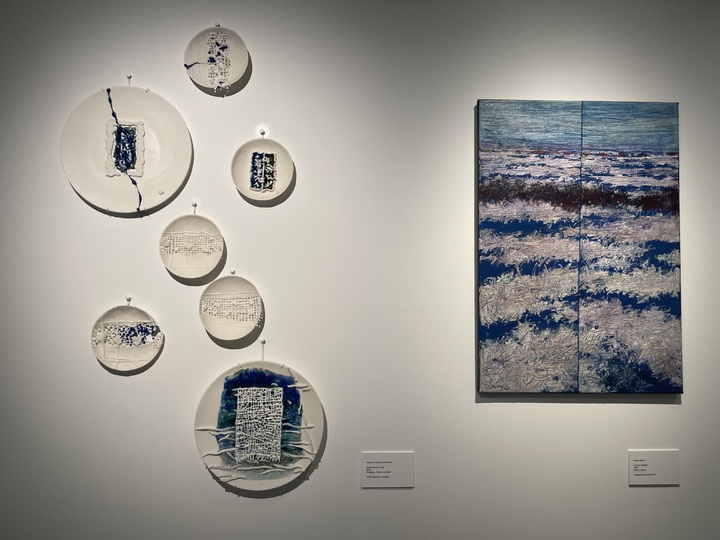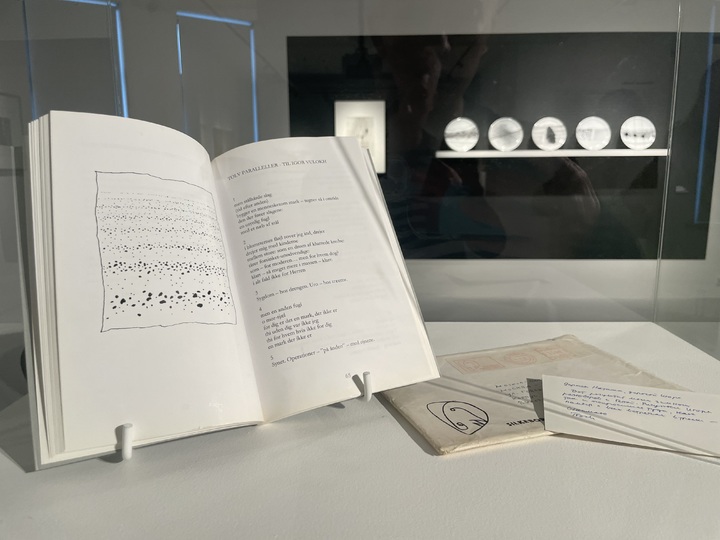Rhymes of contradictions were shown at the exhibition dedicated to the 85th anniversary of Igor Vulokh
[ad_1]
“Twin Fields”. This was the name of the book of poems by Gennady Aigi, published in 1987. The cover of a small collection features an illustration by the poet’s friend, Igor Vulokh, whose work stands apart from the pleiad of his contemporaries, artists of the sixties. Vulokh’s works are on the verge of abstraction and figurativeness: quite specific images of nature are guessed in color or black-and-white fields, however, the color and form itself make a greater emotional impression than a semi-hidden plot. On the occasion of the 85th anniversary of the birth of the artist, in whom the teachers saw a genius even in his youth, an exhibition entitled “Twin Fields” was opened in the museum space Ruarts. On three floors, works are presented along with poems by Gennady Aigi. Color rhymes were read by the MK correspondent.
Igor Vulokh was born in 1938 and died in 2012. This project is perhaps the most ambitious in his lifetime and posthumous biography. The exhibition opens with a small work unusual for Vulokh. Before the audience is a collage created back in the 60s: a picture was assembled from clippings, where a little boy of about four years old sits thoughtfully on a sofa (the author himself), behind his back his mother does something around the house, on the walls and on the floor – his paintings. The fate of this boy was not easy from birth. One of the most difficult experiences fell precisely on that tender age in which Vulokh portrayed himself.
The future artist was born in Kazan – his childhood fell on the years of the Great Patriotic War. In 1942, his father died at the front, and his mother, Lidia Alexandrovna, fell seriously ill and ended up in the hospital. Igor was sent to an orphanage, where he remained until the end of the war. Later, his mother took him away, but, obviously, these few years spent in the orphanage left an indelible mark on the soul of the future artist.
Despite the difficult military and post-war life, Igor showed a talent that was noticed by his teachers at the Kazan Art School, where he studied from 1953 to 1958. His teacher Viktor Podgursky wrote to a friend of the artist Georgy Nissky in Moscow that he had a true genius in his group, as a result, Igor ended up in the capital. His landscape “Winter” was presented at the All-Russian Art Exhibition in the Manege in 1957. And a year later, one of his works became known throughout the Union – it was released on a postcard. Then he tried to enter the Surikov Institute in Moscow, but they did not take him, believing that he … had nothing to teach.
However, thanks to the patronage of Nissky, he entered VGIK. The 20-year-old young man lived in the workshop of “Uncle Zhora”, as he called the mentor. Nissky subsequently helped Vulokh more than once: the mentor secured the opening of Igor’s exhibition in Ermolaevsky Lane, when he was accused of parasitism. He also introduced Vulokh to the works of the artists of the association OST (Society of easel painters), which had a great influence on the young artist.

– Igor wrote like an academician. He was brought from Kazan as a young genius,” says his widow, theater designer Natalia Tukolkina-Okhota. – But in Moscow, his manner begins to transform, thanks to his acquaintance with “other” art. Firstly, the youth festival of 1957 influenced, and secondly, his friend Genna Aigi got a job at the Mayakovsky Museum, where the works of avant-garde artists of the beginning of the century were kept in the funds. This acquaintance had a huge effect on Vulokh, because he had never seen anything but realistic understandable painting before, and here it is…
By the way, Aigi ended up in the Mayakovsky Museum under dramatic circumstances. He dreamed of meeting Boris Pasternak, and their meeting took place. And when the persecution of the writer began, Aigi came out in support of him, and for this he was expelled from the Literary Institute. Somehow I got a job at a chemical plant, but it was a hell of a job that left no chance for poetry. Having learned about the difficulties of Aigi, composer Andrei Volkhonsky helped him get a job at the Mayakovsky Museum, where later, together with Igor, he made several exhibitions of “leftist art” – Malevich, Tatlin, Filonov, Matyushin, Chekrygin, Goncharova. Vulokh himself was not officially listed in the Mayakovsky Museum. Works commissioned by the Production Fund of the USSR Art Combine brought some income. Money was always tight, but he continued to go his own way in art.
Three floors of the exhibition clearly demonstrate what this road was like. Before us are fields where the landscape gives out only the horizon line. The viewer has a lot of room for conjecture and interpretation. Other works are reminiscent of sea waves, and the white “lambs” are not written out, but are scribbled on canvas. There are paintings where the focus is on an object whose essence is difficult to determine: it seems that we have a pebble in front of us, but it is felt like a philosophical block. Vulokh’s works produce primarily an emotional, mental effect. The power of a “quiet” calm color, for inexplicable reasons, causes deep excitement. Under the pictures you can read some quotes of the master. Here is one of them: “I am attracted by certain collisions, but not stormy, contradictions, which eventually become a continuous part of the expression of things.” It seems that this is the answer to the question of why the artist’s works both calm and cause inner tension and awe.
“Art told them, it was its nature,” says the artist’s daughter Lydia Vulokh. – He did not analyze what he was doing, he did not write any manifestos. But the audience says: we approach the pictures, and we feel good. Despite the fact that he had a difficult character and a life full of hardships.

Yes, Vulokh’s painting was born in conflict with real life and the artistic process. Having once received recognition as a 19-year-old boy, for most of his life he could not exhibit, because art on the verge of abstraction did not correspond to the canon adopted in Soviet times. And yet, in narrow, understanding circles, Vulokh’s painting was idolized. According to his widow Natalia, the Russian Museum made attempts to buy or donate his work. She herself fell in love with the work of her future husband at first sight.
“A friend once invited me to a party, he was the son of a classmate of Vulokh,” says Natalia. – I came, saw the pictures on the walls and was stunned. She stood and couldn’t move. There we met. The novel happened later. Once Vulokh came to me to look at the work, and did not come out. That evening, a fan came to visit, they sat in the kitchen for a long time, who would outlast whom, as a result, Igor won. For a year he did not drink at all, we were engaged in something else – love. Then I found out that I was pregnant, and doubted whether to leave the child. I already had a son from my first marriage, Igor had a daughter. And we are two artists without a regular income. There was never money. And then Genna Aigi came, guessed that I was expecting a baby, and convinced me to leave. So he can be said to be Lida’s godfather.
Natalia’s works are also on display at the Twin Fields exhibition. And in these theatrical costumes and artistic ceramics, a direct connection with the painting of her husband is felt. The works are presented side by side, so the intersections are easy to count. There are other interventions at the exhibition: the works of Aidan Salakhova, Vladimir Yakovlev, Valery Gente-Rote, Daniil Antropov and the young artist O331c (pseudonym) enter into a dialogue with the painting and graphics of Vulokh, on the one hand emphasizing his originality, on the other, revealing unobvious connections and the influence of the now recognized classic. There are Aigi’s poems at the exhibition, which gave the name of the exhibition.
The project is conditionally divided into three sections – “Twin Fields”, “Twin Hills” and “Gulley Time”. They show the work of Vulokh outside the chronology of life, but rather divide it into color and emotional sectors. One of the floors is almost completely given over to the artist’s white works: light shades predominate here. Natalia says that experiments with whites went in parallel with colored ones: “Either he rested on them, or gained energy.” The viewer here among the white fields is also resting. And the final section shows bright color and deaf black-and-white works. Here the viewer is overcome with excitement.
[ad_2]
Source link






